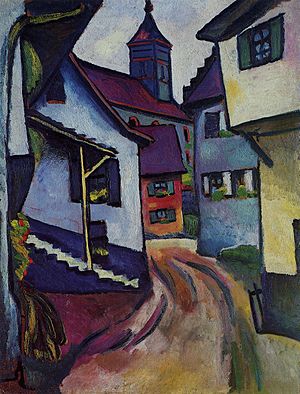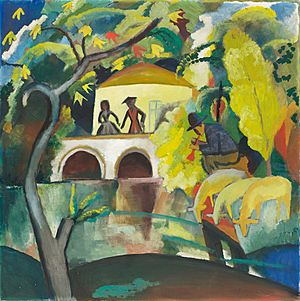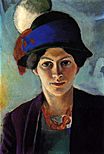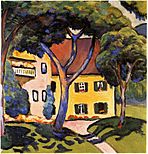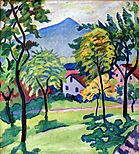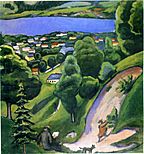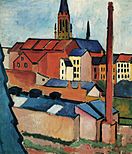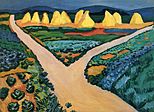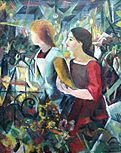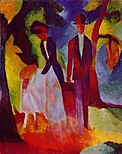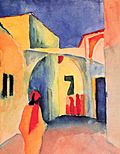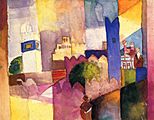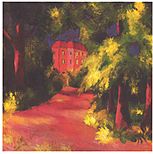August Macke facts for kids
Quick facts for kids
August Macke
|
|
|---|---|
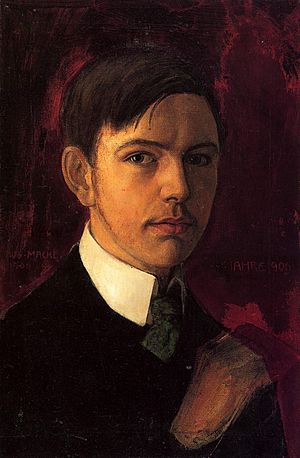
August Macke, Self-portrait, 1906, oil on canvas
|
|
| Born | 3 January 1887 Meschede, German Empire
|
| Died | 26 September 1914 (aged 27) near Perthes-lès-Hurlus, Champagne, France
|
| Nationality | German |
| Known for | Painting |
| Movement | Expressionism |
August Macke (born January 3, 1887 – died September 26, 1914) was an important German painter. He was a leading member of a German art group called Der Blaue Reiter (The Blue Rider).
Macke lived during a very exciting time for art in Germany. He saw many new art styles develop. He also learned from new art movements happening in other parts of Europe. Like many artists of his time, Macke used ideas from these new art styles in his own paintings. Sadly, he was one of many young German artists who died in World War I.
Contents
Early Life and Art Beginnings
August Robert Ludwig Macke was born in Meschede, Germany, on January 3, 1887. He was the only son of August Friedrich Hermann Macke, who built houses and was also an amateur artist. His mother, Maria Florentine, came from a farming family.
Soon after August was born, his family moved to Cologne. There, Macke went to school and became friends with Hans Thuar, who also became an artist. In 1900, when he was 13, his family moved to Bonn. Here, he became friends with Walter Gerhardt and his sister, Elisabeth. August would later marry Elisabeth.
The first artworks that really impressed young August were his father's drawings. He also loved the Japanese prints that his friend Thuar's father collected. In 1900, he saw the paintings of Arnold Böcklin during a trip to Basel, which also made a big impression.
In 1904, Macke's father passed away. That same year, Macke started studying art at the Kunstakademie Düsseldorf. He also took evening classes and worked as a designer for theater stages and costumes. He traveled to northern Italy in 1905, and to the Netherlands, Belgium, and Britain in 1906.
Becoming an Artist (1907–1914)
After his studies, Macke lived mostly in Bonn. He also spent some time near Lake Thun in Switzerland. He made several trips to Paris, Italy, the Netherlands, and Tunisia.
In 1907, Macke visited Paris for the first time. There, he saw the works of the Impressionists. These artists used small, thin brushstrokes to show light and movement. Soon after, he went to Berlin and studied in Lovis Corinth's art studio.
Macke's early style was influenced by French Impressionism and Post-impressionism. Later, he went through a period influenced by Fauvism. Fauvism used very bright and strong colors. In 1909, he married Elisabeth Gerhardt.
In 1910, Macke became friends with Franz Marc. Through Marc, he met Wassily Kandinsky. For a while, Macke shared their interest in art that didn't show real objects, but focused on feelings and symbols. This was part of the Der Blaue Reiter group.
A big moment for Macke was meeting Robert Delaunay in Paris in 1912. Delaunay's style, called Orphism, used bright colors and geometric shapes. This style greatly influenced Macke's art from then on. His painting Shops Windows shows his own take on Delaunay's ideas, mixed with the idea of showing many things at once, like in Italian Futurism.
In April 1914, Macke traveled to Tunisia with Paul Klee and Louis Moilliet. The unique atmosphere of Tunisia was very important for his final period of painting. During this time, he created many masterpieces that used a bright, glowing style called luminism.
Macke's art is often seen as part of Expressionism. This German art movement, popular between 1905 and 1925, focused on showing feelings and moods. Artists often changed colors and shapes to express these feelings, rather than showing things exactly as they looked.
Sadly, August Macke's art career was cut short. He died early in World War I, on September 26, 1914. He was fighting on the front lines in Champagne, France. His last painting, Farewell, shows the sad mood that came after the war started. He also painted his famous Türkisches Café in München (Turkish Café in Munich) in 1914.
Selected Paintings
-
Kairouan (III), 1914, watercolor, Westphalian State Museum for Art and Cultural History, Münster
August Macke Prize
The August Macke Prize is an award given to artists. It was first given in 1959 by several districts in Germany, including Meschede, where August Macke was born.
August-Macke-Haus Museum
The August-Macke-Haus is a museum dedicated to August Macke. It opened in 1991 and is located in Macke's former home in Bonn. He lived there from 1911 to 1914.
See also
 In Spanish: August Macke para niños
In Spanish: August Macke para niños


